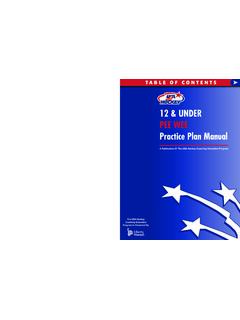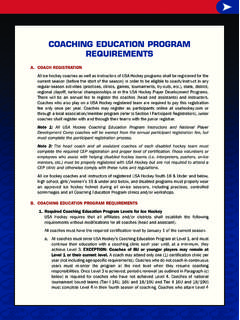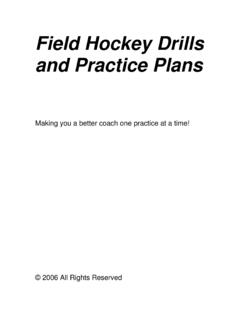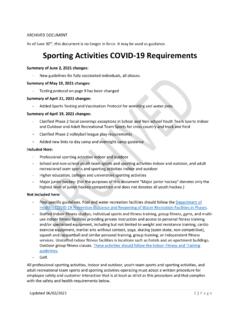Transcription of 10 & UNDER SQUIRT Practice Plan Manual - CacheFly
1 10 & UNDER SQUIRTP ractice plan ManualA Publication Of The USA Hockey Coaching Education Program1775 Bob Johnson DriveColorado Springs, CO USA HockeyCoaching EducationProgram Is Presented ByTABLE OF CONTENTSTABLE OF CONTENTSTABLE OF CONTENTSC opyright 2010, USA Hockey, RIGHTS RESERVEDNo part of this publication may be reproduced, stored in a retrieval system, or transmitted, in any form or by anymeans, electronic, mechanical, photocopying, recording, or otherwise, without the prior permission of of Congress Cataloging in Publication Data:Belmonte, Val, 1951 -Emahiser, Dick, 1952 - Practice plan Manual For 10 & UNDER ( SQUIRT ) Practice plan Manual For10 & UNDER ( SQUIRT )PhilosophyAreas of DevelopmentPractice PlansDrillsByVal BelmonteDick EmahiserEdited ByMark TabrumProductionDana AusecTechnical AdvisorsVal BelmonteDick EmahiserMike MacMillanBob O'ConnorMatt WalshTABLE OF CONTENTSI ntroduction3 TABLE OF CONTENTSL egend.
2 2 Introduction .. 4 Objectives & Philosophy .. 4 The Coach .. 4 Recommended Program .. 5On-Ice & Off-Ice Training .. 5 Development of Speed .. 6 Physical & Psychological Preparation .. 6 Technical & Tactical Preparation .. 6 Skills & Abilities .. 7 Sample Practice plan .. 8 Practice Plans .. 11 Additional Drills .. 103 LEGENDB ackward SkateBackward Skate With PuckDrop PassForward SkateForward Skate With PuckForward StrokePass ShootStop2 IntroductionDedicationThis Manual is dedicated to Ken Johannson, one of the founders of USA Hockey sCoaching Education Program. Ken wrote USA Hockey s first coaching Manual as well asdesigned the original curriculum for the coaching PlansTABLE OF CONTENTSI ntroduction5 INTRODUCTIONAs part of an ongoing effort to promote enthusiasm and enjoyment in hockey, USA Hockey has prepareda Practice plan Manual for 10 & UNDER (Squirts).
3 The objective of this Manual is to provide coaches with the resources to create a positive and healthyenvironment for players to learn. The emphasis is to develop a non-competitive environment for the youngerage levels that stresses the fun of playing and the learning of basic Manual provides the coach with the knowledge to develop successful Practice sessions. The drillshave been developed to stress the youngsters' individual improvement. The fundamental skills of skating,puck control, passing, shooting and checking are presented in a progressive is important that coaches prepare and organize their session prior to going on the ice.
4 The betterthought out a Practice , the more successful it will be. Coaches are encouraged to use their own imaginationto create overall emphasis at the 10 & UNDER ( SQUIRT ) level is fun, enjoyment, and a maximum amount ofactive participation for each Enjoyable introduction and experience in ice hockey. Provide a healthy atmosphere for fun and learning. Introduce the concept of games and the fun in playing hockey. Development of communication at the player s level of learning. Encourage the players to enjoy, learn and continue to play hockey. Develop qualities important to hockey: quickness, agility, coordination, balance, strength and and recreational benefits are the major focus of new guidelines for youth hockey issued bythe USA Hockey Board of Directors.
5 More than 80% of registered teams play in the classification of 8 & UNDER (Mite), 10 & UNDER ( SQUIRT ), 12 & UNDER (Pee Wee), 14 & UNDER (Bantam), 16 & UNDER (Midget),18 & UNDER (Midget), prompting the Youth Council of USA Hockey to emphasize the educational andrecreational values of ice USA Hockey recommended guidelines for youth hockey encourage an environment in whichchildren and youth can learn the basic skills without the distractions that are often associated with anoveremphasis on winning. Mastery of the fundamental skills and the fun of playing are essential to thedevelopment of a lifelong interest in hockey.
6 Programs must be conducted to accommodate the number ofnew players who wish to play hockey and to reduce the number who become disenchanted and drop voluntary guidelines are directed at youth programs, but they must be implemented by adults ifthey are to influence youth hockey programs. Coaches, parents, administrators and rink operators must alldo their part to ensure that the USA Hockey philosophy and the following guidelines are COACHYour impression upon these young players is profound. How they relate to the game of hockeydepends upon you. Your role is vital and heavy with Shapes the player s views through their actions and attitudes.
7 At times, plays a more important role than the child s parents. Is a teacher. Is a s Code of Conduct: Hockey is fun. Honest representation; skills should decide the final outcome of games. Opponents are to be respected and complimented. Rules and regulations are to be viewed as mutual agreement in spirit and trust. Officials are to be viewed as honest arbitrators. Winning is a consideration, but not the only one, nor the most important one. Set a good example of Players to: Play for the love of the game. Respect their opponent. Play for the good of the team. Accept the official s decisions and respect their judgment.
8 Play within the rules of the game. Be generous in victory and gracious in defeat. Always conduct yourself with honor and pride. To play the game is great, to win the game is greater, to LOVE the game is the PROGRAMS. Three practices to every game. Practice sessions lasting one to one and a half hours. While emphasis of development of the fundamental skills is still important, it becomes important that more time is now spent teaching the principles of the games maximum = 75 practicesON-ICE TRAINING One hour Practice Individual instruction Fun games Scrimmage Cross ice and small game activities Skating Passing and receiving Shooting Puck handlingPrepare interesting and challenging Practice sessions.
9 Utilize all the variables within each time allotment, , backward skating, turning, etc., within the skating time TRAINING Only for those who wish to participate. Stress flexibility. Encourage players to participate in all sports. Develop qualities important to PlansTABLE OF CONTENTSI ntroduction7 DEVELOPMENT OF SPEED Sudden bursts in different directions Obstacle courses Track and field Soccer Jumping Team combination drills WrestlingPHYSICAL PREPARATION Daily physical education. Stress proper posture. Include games and activities that involve physical contact and rough and tumble play in a safe andorganized environment.
10 Stress agility, quickness, balance, coordination and dexterity. Encourage the players to participate in school activities and other sports. Flexibility drills. Alternate work and rest periods. Youngsters are easily PREPARATION By seeking alignment with peer groups, team loyalty develops. These youngsters need the coach sapproval and encouragement. Help the players develop self-reliance and independence. Build confidence. Stress group participation and sharing, but be aware of the individual needs of the youngster. Support and protect the youngster in situations they are not prepared to PREPARATION Introduction of specific skills by position.








